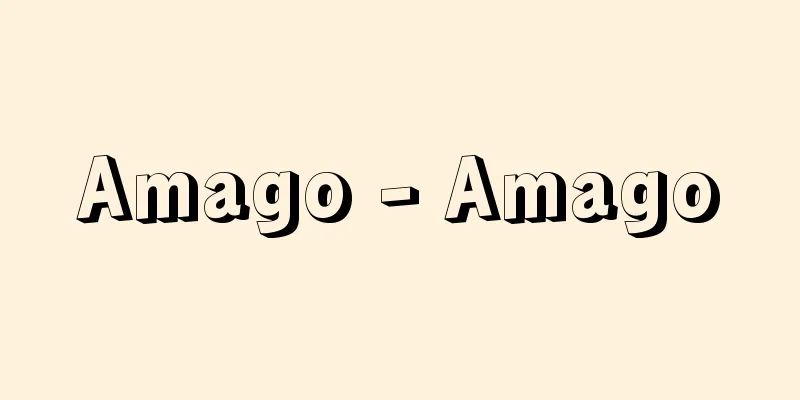Nanban trade

|
Trade that took place between Japan and trading ships from Portugal and Spain from the mid-16th century to the 17th century. [Takeichi Matsuda] initialFrom the end of the 15th century to the 16th century, both Portugal and Spain were in the heyday of the Age of Discovery, with the Portuguese based in Goa on the west coast of India and the Spanish in Mexico, competing for supremacy in Asia for the purposes of trade and the propagation of Catholicism. In this trend, in 1543 (Tenbun 12), a Portuguese man was cast ashore on Tanegashima Island in southern Satsuma, marking the beginning of negotiations between Japan and Portugal. Around 1557 (Koji 3), the Portuguese established a trading base in Macau, which allowed them to take over exclusively as a transit trader the trade between Japan and Ming China that had been completely cut off at the time due to the rampant Wako pirates. At the time, Portuguese trade was always closely linked to the Catholic missionary work led by the Society of Jesus, so trade ships bound for Japan naturally chose to dock in the territories of feudal lords who protected Christianity. Nagasaki, which was established as a port city in 1571 (Genki 2), was donated to the Society of Jesus by its feudal lord, Omura Sumitada, and Portuguese ships began to dock there every year. The Portuguese royal family rewarded aristocrats who had served the country for many years with the title of Captain Maur, who governed colonies in the East and supervised trading fleets, collecting profits from them. For trade with Japan, the Captain Maur came to Japan every year on an official ship. The funds required for the voyage were mainly collected from investments made by powerful merchants, the senate, and various organizations in Macau, and profits in Japan were distributed according to the amount of investment. The route to Japan was to first set sail from Goa, pass through Malacca, and stop in Macau, where the European silver coins, olive oil, wine, spices from the South Seas, and medicinal herbs that had been imported up until then were transshipped to expensive goods such as raw silk, gold, and silk fabrics bound for Japan. The Captain Maur arrived in Nagasaki in June or July on the seasonal winds from the south, and after trading, returned to Macau on the seasonal winds of late autumn and early winter. The ships were large sailing ships called nau (500-1000 tons), and all the goods they loaded down were paid for in Japanese silver. The amount reached 500,000-600,000 ducados (a unit of Spanish silver coin used as international currency, equivalent to about 10 momme of Japanese silver) every year, and it was not uncommon for net profits to exceed 100%. The majority of exports from Japan were made of this silver, which met the enormous demand for silver in China. Other examples include wheat, lacquerware, ship materials, copper, and iron. Chinese raw silk remained the top export product to Japan throughout the years, but in the early 17th century, the Edo Shogunate established the Itowappu system and implemented price controls on imported raw silk. [Takeichi Matsuda] Late PeriodIn the 17th century, Chinese junks (rongx, distinctive sailing ships) resumed trade with Japan after a long absence, and the Japanese themselves, as exemplified by the red seal ship trade, became active overseas. Furthermore, in 1600 (Keicho 5), the Dutch ship Liefde was washed ashore, and Protestant countries such as the Netherlands and England entered the Japanese market, which posed a great threat to Nanban trade and reduced its value. In an attempt to break Portugal's monopoly on trade with Japan, both England and the Netherlands encouraged the shogunate to have "aggressive ambitions" through Catholic missionaries, while at the same time using their mobility to attack and plunder Portuguese ships in the South Seas. As a result, Macau City was often cut off from supplies and financial sources from Goa, and was forced to borrow large amounts of money from Japanese merchants as trading assets. Due to the decline in net profits caused by merchant interest and the thread-transfer system, many Portuguese merchants found it difficult to repay their debts, accelerating the decline of trade with Nanban. Contrary to the shogunate's expectation that the power of Christianity would rapidly weaken after the so-called Great Expulsion in 1614 (the banishment of many Christians and missionaries, including Takayama Ukon, to Manila and Macau), missionaries continued to infiltrate Japan from abroad. The arrival of Nanban ships, which played a role in helping Christians infiltrate Japan, was disliked by the shogunate, and in 1624 (Kan'ei 1), first trade with Japan by Spanish was cut off, and the following year, restrictions were imposed on Portuguese who came to Japan for trade. Despite the strenuous efforts of Macau city authorities, who considered the survival of trade with Japan a matter of life and death, the Portuguese were isolated in Dejima in Nagasaki Bay from 1634 onwards, cut off from contact with ordinary Japanese people, and placed under strict surveillance. Furthermore, between 1633 and 1636, the shogunate issued an order to close the country, and further tightened restrictions on trade. Following the Shimabara-Amakusa Rebellion in 1637, the shogunate finally decided to abandon the profits of trade by Portuguese ships and to eradicate Christianity, and in 1639 banned the arrival of Portuguese on Japanese shores under penalty of death. The following year, a Portuguese envoy came to Japan to plead for the resumption of trade, but everyone there was executed, except for the lower-ranking crew, and thus came to an end the century-long trade with Nanban. [Takeichi Matsuda] "Nagasaki City History: Trade and Exchange Section on Western Countries" by Murakami Naojiro (1935, Nagasaki City)" ▽ "Koda Shigetomo's History of Trade and Exchange between Japan and Europe (1942, Iwanami Shoten)" ▽ "Takase Koichiro's Research on the Christian Era (1977, Iwanami Shoten)" Source: Shogakukan Encyclopedia Nipponica About Encyclopedia Nipponica Information | Legend |
|
16世紀なかばから17世紀にかけて、日本とポルトガル、スペインの貿易船との間に行われた交易。 [松田毅一] 初期15世紀末から16世紀にかけ、ポルトガル、スペイン両国は大航海時代の全盛期を迎え、ポルトガル人はインド西岸のゴアに、スペイン人はメキシコに根拠地を置き、貿易とカトリック布教を目的としてアジアでも覇を競った。この趨勢(すうせい)のもとに、1543年(天文12)ポルトガル人が薩南(さつなん)の種子島(たねがしま)に漂着し、日ポ交渉の端緒が開かれた。1557年(弘治3)ごろポルトガル人はマカオ(澳門)に貿易基地を設けるが、これにより彼らは、当時、倭寇(わこう)の猖獗(しょうけつ)のためにまったく途絶していた日明(にちみん)間の通交を中継貿易の形で独占的に肩代りすることになった。当時、ポルトガル人の貿易は、つねにイエズス会の主導によるカトリック布教と密接にかかわりがあったから、日本への貿易船も、おのずからキリスト教を保護する大名の分国を選んで入港するに至った。1571年(元亀2)港市として開かれた長崎が、領主大村純忠(すみただ)によってイエズス会に寄進されると、以後、ポルトガル船は毎年その地に入港するに至った。 ポルトガル王室は、多年国家に勲功のあった貴族に、恩賞としてカピタン・モールという地位を与えて東洋における植民地を統轄させ、さらに交易船団を監督させて、そこからあがる利益を収得させた。日本貿易においても、カピタン・モールが、毎年、官許船で渡来した。航海に要する資金は、おもにマカオの有力商人や元老院、各種団体からの出資を集積したもので、日本での利潤は出資額に応じて配分された。渡日の経路は、まずゴアを出帆し、マラッカを経、マカオに寄り、それまで舶載してきたヨーロッパの銀貨やオリーブ油、ぶどう酒や南海産の香料、薬種などを、日本向けの生糸をはじめ、金、絹織物などの高価な商品に積み換え、南方からの季節風にのって、6、7月ごろ長崎に入港、取引ののち、晩秋・初冬の季節風でマカオに戻った。船はナウ(500~1000トン)とよばれる大型帆船で、満載してきた商品の代価はすべて日本の銀で支払われた。その額は毎年50万~60万ドゥカード(国際通貨として用いられたスペイン銀貨の単位で、日本の銀10匁前後に換算)に達し、100%以上の純益があがるのもまれではなかった。日本からの輸出品の大半はこの銀であって、中国における莫大(ばくだい)な銀の需要に応じた。以下、小麦、漆器、船材、銅、鉄などをあげうる。中国産の生糸は、終始、日本への輸出品の首位にあったが、17世紀の初頭、江戸幕府は、糸割符(いとわっぷ)制度を設け、輸入生糸の価格統制を実施した。 [松田毅一] 後期17世紀に入ると、長らく来航を停止していた中国のジャンク(戎克。独特の帆船)が日本貿易を再開し、朱印船貿易に代表される日本人自身の海外進出も盛んになった。さらに1600年(慶長5)オランダ船リーフデ号の漂着を契機として、オランダ、イギリスなどプロテスタント諸国が日本市場に参加するに至ったことは、南蛮貿易にとり大いなる脅威であり、その存在価値を低下せしめた。イギリス、オランダ両国は、ポルトガルの対日独占貿易態勢を打破しようとして、カトリック宣教師を媒介とする「侵略的野心」を幕府に鼓吹する一方、南海においては、その機動力をもってポルトガル船を襲撃し、略奪した。このために、マカオ市では、ゴアからの補給や資金源をしばしば断たれ、貿易資産として、日本の商人からの多額の借財を余儀なくされた。その商利息や糸割符制度に起因する純益減少のために、ポルトガル商人のなかには、債務履行に窮する者が続出し、南蛮貿易の衰微に拍車がかかった。 1614年(慶長19)のいわゆる大追放(高山右近(うこん)ら多数の信者や宣教師をマニラ、マカオに追放)によって、キリシタンの勢力は急速に弱まるであろうとの幕府の推測に反し、国外から日本に潜入する宣教師は後を絶たなかった。この潜入を助ける役割を果たしていた南蛮船の来航は、幕府の嫌悪するところであり、1624年(寛永1)まずスペイン人の対日貿易が断たれ、さらに翌年以降、貿易のために渡来するポルトガル人に対する取締りが行われた。日本貿易の存続を死活の問題としてとらえるマカオ市当局者の懸命の努力もむなしく、ポルトガル人は、1634年以降、長崎湾の出島(でじま)に隔離され、一般日本人との接触も遮断されて、厳しい監視下に置かれた。さらに1633年から36年までの間、幕府は鎖国令を発し、貿易に関する取締りをいっそう厳重にした。1637年の島原・天草一揆(いっき)を機に、幕府はついに、ポルトガル船による貿易の利を捨てて、キリシタンの根絶を図ることを決意し、1639年、ポルトガル人の来航を死罪をもって禁ずるに至った。翌年、貿易の再開を嘆願する目的で来日したポルトガル使節の一行は、下級船員を除いて、ことごとく処刑され、ここに1世紀にわたった南蛮貿易は終焉(しゅうえん)を迎えた。 [松田毅一] 『村上直次郎著『長崎市史 通交貿易編西洋諸国部』(1935・長崎市)』▽『幸田成友著『日欧通交史』(1942・岩波書店)』▽『高瀬弘一郎著『キリシタン時代の研究』(1977・岩波書店)』 出典 小学館 日本大百科全書(ニッポニカ)日本大百科全書(ニッポニカ)について 情報 | 凡例 |
<<: Nambiqwara - Nambiqwara (English spelling)
Recommend
Incense - Neri-ko
musk Jack・Agarwood Humanity This incense is made ...
Pierre de Coubertin
The founder of the modern Olympic Games. A French...
planta
...A perennial plant of the Plantaginaceae family...
ACD - Automatic Call Distributor
Automatic call distribution device. A device that ...
payola
...In this system, the publishers would make song...
Joule's heat
…When an electric current flows through a conduct...
Nuclear weapon
A weapon that uses an explosive release of energy...
Uherské Hradiště - Uherské Hradiště
…Downstream, it is navigable for about 130 km. Ci...
Kazurabashi Bridge - Kazurabashi Bridge
Located in Zentoku, Miyoshi City, in the west of T...
Saishokoin Temple
This was one of Emperor Goshirakawa's temples,...
Slawen Kongress (English spelling)
The first Slavic national assembly was held in Pr...
bounded
… If a is an upper bound of a set E , then every ...
Textbook Certification System - Authorization of textbooks
A system that sets certain standards for textbooks...
Becker, H.
…He was interned during World War I, but returned...
Botia macrocanthus (English spelling)
...Breeding is somewhat difficult. (d) Clown loac...









